Bulletin – July 1993 Financial Markets and the Economy in the June Quarter
- Download 110KB
The international economy remains sluggish, and assessments of short-term prospects have been revised down again over the past few months. 1993 is now expected to be the third straight year of growth of little more than 1 per cent in the industrial countries. Some of Australia's important trading partners – particularly in East Asia – are recording better growth, but commodity prices remain quite low.
The global situation remains a constraint on the near-term potential for expansion in the Australian economy, which is still recording only modest growth. Capacity utilisation in most sectors is low and employment is flat. Business investment remains weak.
Underlying inflation remains low, at around 2 per cent over the year to March. Recent indicators of materials and labour costs suggest that price pressures in domestic markets are still quite subdued. ‘Headline’ rates of CPI increase are moving up, however, as the effects of earlier falls in interest rates pass out of the picture and the effects of increases in government taxes and charges show up. Higher import prices, consequent upon a falling $A, which have been observed at the wholesale level over the past year, also are now affecting prices paid by consumers, albeit slowly.
The weakness of the exchange rate, which fell by about 6 per cent during the June quarter, again limited the scope for monetary policy to be eased further, and cash rates were unchanged during the quarter. Bank and other intermediary interest rates generally declined by about ½ per cent during April and May, following the decline in cash rates in late March.
The International Economy
Graph 1 summarises trends up to the March quarter in the economic regions of most interest to Australia.
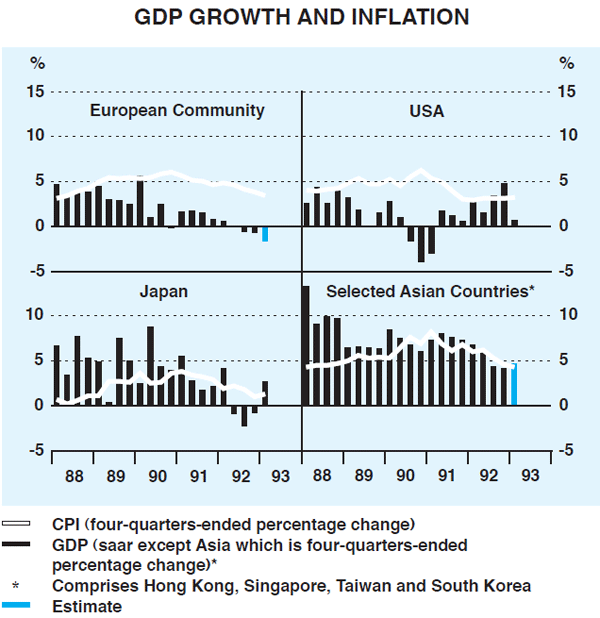
Activity in the United States picked up a little during the June quarter, after a weaker March quarter. Industrial production slowed, constrained by inventories built up during earlier months as a result of weak demand, but growth in other sectors picked up. Employment posted further gains, holding the unemployment rate to around 7 per cent in the June quarter, compared with 7.5 per cent a year earlier. The resulting growth in household incomes helped, despite indications of falling consumer confidence, to re-establish an upward trend in retail sales. Housing starts also recovered, and share prices moved higher.
Longer-term economic prospects have been improved by the passage (with modifications) of President Clinton's deficit-reduction program through the House of Representatives in May and the Senate in June. The fiscal package includes tax increases and spending cuts aimed at halving the Federal budget deficit, as a ratio to GDP, over a four-year period. The package is expected to be reconciled and then passed by both Houses of Congress before the August recess.
Price increases slowed in the United States during May, after several months of relatively large rises in monthly price indices. These had raised speculation in some quarters that US monetary policy might be tightened, and market interest rates had moved up. In the event, the Federal Reserve left monetary policy settings unchanged. The underlying rate of consumer price inflation appears to be around 3 to 3½ per cent, with labour cost increases running well below that rate.
After contracting for three quarters, the Japanese economy recorded growth in real GDP of 0.7 per cent in the March quarter, on the back of a recovery in private consumption from low December quarter levels, and an increase in public sector spending flowing from the fiscal stimulus package enacted last year. A second fiscal package passed the Diet and is expected to have an impact on the economy later in the year. The share market responded positively to the package. Private sector demand, however, remains subdued, with both business and consumer confidence low. The sharp rise in the yen over recent months (Graph 2) is likely to hamper export growth. Increased political uncertainty has also complicated the short-term outlook, with the Japanese Government forced to an election, to be held on 18 July.

Rapid economic growth in China has helped other East Asian economies, especially Hong Kong and Taiwan, to maintain strong growth despite the recessions in North America and Japan. There are now increasing concerns about inflation in China, however, and steps are being taken to slow the rate of growth.
In South Korea policies are now stimulatory, after a period of restraint directed towards lowering inflation. Singapore and Malaysia continue to record strong growth. Tighter policies in Thailand and the effect of global recession on Indonesian oil exports have slowed activity in those countries, but growth in both remains high by Western standards.
Economic activity in Europe is still suffering the effects of a contracting German economy. Real GDP in western Germany fell by 1.5 per cent in the March quarter, the fourth consecutive fall. Indicators for the June quarter are consistent with further weakness. Activity is also flat or falling in most other European countries, with industrial production and employment well below levels of a year ago in almost every case (Table 1). The main exception is the United Kingdom, where a modest recovery in output is now under way, after a deep and prolonged slump.
| Industrial | Employment Production | ||||
|---|---|---|---|---|---|
| France | −3.5 | Apr | −0.9 | Mar | |
| West Germany | −8.3 | May | −1.5 | Apr | |
| Italy | −3.6 | Apr | −4.9 | Mar | |
| Netherlands | −1.4 | Apr | 0.0 | Dec | |
| Spain | −6.6 | Mar | 0.0 | Jun | |
| Sweden | −4.1 | Mar | −5.8 | Apr | |
| Switzerland | −4.2 | Mar | −4.2 | Mar | |
| United Kingdom | +1.4 | Apr | −2.8 | Dec | |
Inflation in most European countries is relatively low, but remains a policy concern in Germany. Western German consumer prices rose by 4.2 per cent over the year to May, although part of this increase (approximately half of a percentage point) reflected the rise in the value-added tax in January.
German short-term interest rates have fallen by about 0.6 of a percentage point since March. Those in other European countries have fallen by more than this, with authorities taking advantage of a weaker Deutschemark (Graph 2) to ease monetary policy. By early July, several countries had lower interest rates than Germany.
The Domestic Economy
Activity and employment
Economic activity has continued to expand at a relatively sluggish pace over recent months (Graph 3). The average measure of real GDP rose by 0.5 per cent in the March quarter, to be about 2½ per cent higher than a year earlier. Consumer spending was subdued, while dwelling investment fell slightly. Business investment remains low. Public spending grew strongly in the quarter, more than offsetting the weakness in private demand. Net external demand was weak, with the fall in net exports equivalent to 0.5 per cent of GDP. Part of the increase in production went into stocks.

The indicators available for the June quarter provide little evidence of any pick-up in the pace of growth. Consumer spending has been constrained by subdued household income growth, a result of flat employment and modest wages growth. The value of retail trade rose by 0.7 per cent in April, and a further 2.9 per cent in May, to be about 4 per cent higher than a year earlier. This followed three quarters in which real retail trade had fallen (Graph 4). Registrations of passenger vehicles fell by 4.2 per cent in May following a rise of 1.8 per cent in April. Average registrations in these two months were 1.5 per cent higher than in the March quarter, but still at quite low levels overall. Consumer sentiment, as measured by the Westpac/Melbourne Institute survey, increased in April and May but fell sharply in June. The trend over the past year has been flat.

Leading indicators suggest that a slowing in the pace of expansion in housing construction is in prospect. The number of private dwelling commencements rose by 0.4 per cent in the March quarter, after rising by 3.2 per cent in the December quarter. Building approvals for private dwellings were 0.6 per cent lower in the three months to May than in the three months to February, suggesting that commencements may be close to flattening out. Housing finance approvals, however, continue at high levels, after showing signs of falling off earlier in the year, helped by a reduction in mortgage rates and intense competition among lenders.
The real value of non-residential commencements rose by 5.2 per cent (not seasonally adjusted) in the March quarter, reflecting the rise in approvals since mid 1992. The increase in approvals has been concentrated in shops and factories, which have more than offset falls for offices and hotels.
Manufacturing output rose by around 3½ per cent between the middle of 1992 and the March quarter of 1993. The latest ACCI/Westpac survey of the manufacturing sector points to a further increase in the June quarter. A significant proportion of respondents reported increases in output and orders and, in contrast with the past couple of years, outcomes were in line with expectations formed three months earlier (Graph 5). The increase in output was accompanied by a modest rise in the rate of capacity utilisation (though this remains quite low) and the majority of respondents expect their profits to rise over the next year.

A substantial pick-up in business investment is the major missing ingredient in the recovery and remains crucial to any acceleration in the pace of growth. Given the progress that has been made on repairing balance sheets, that factor should no longer be a general constraint to investment. Corporate profitability also has increased and there are a number of tax incentives in place. To date, however, excess capacity, sluggish demand growth and uncertainty over the outlook have outweighed these positive factors. Respondents to the ABS survey of capital expenditure are not yet signalling a big expansion in capital spending. Although the latest reading for 1993/94 is higher than the initial estimate, it remains below the corresponding reading for 1992/93 taken a year ago. In the latest survey, mining is the only major sector expecting a substantial rise, although about one-third of respondents to the ACCI/Westpac survey of manufacturers expect to increase their investment in plant and equipment over the next twelve months.
External demand is providing little stimulus to the Australian economy at this time. Exports of goods and services fell by 3.7 per cent in the March quarter; statistics for April and May suggest only a partial reversal of this fall.
With weak output growth, labour market conditions remain subdued. There is some evidence of a small increase in aggregate demand for labour. Full-time employment has been rising since late 1992, for example, while part-time employment has been falling. This shift from part-time to full-time work, together with higher overtime hours worked, suggests a small rise in total hours worked in the economy. Job vacancy series also have been rising, although not at a uniform pace. The vacancies measure compiled by the ABS rose by 9.5 per cent in the three months to May, more than reversing a fall in the previous quarter, to be 24 per cent higher than a year earlier. This series, however, may be affected by the operation of government-funded wage-subsidy programs, and may overstate the underlying demand for labour in the private sector. Other measures of vacancies are weaker, though still higher than a year ago. The ANZ measure, for example, based on newspaper advertisements, was 2.3 per cent higher on average in the June quarter, and nearly 10 per cent higher than a year earlier.
There has been no real pick-up in aggregate numbers employed. Employment fell by 75,000 in April and then rose by 84,000 over May and June. Monthly fluctuations aside, employment is little changed since mid 1991 (Graph 3). The public sector and large corporate employers have continued to shed staff during the recovery, about offsetting growth in numbers employed in smaller private businesses.
With little employment growth, the rate of unemployment has only fallen below the peak of 11.3 per cent reached late last year because of lower rates of labour force participation (Graph 6).
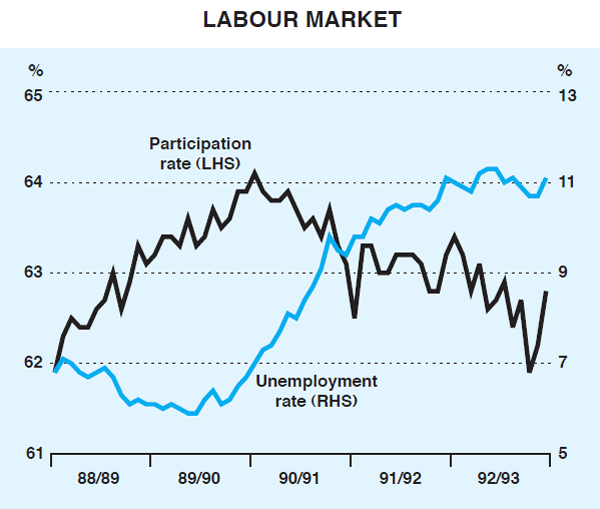
Prices and costs
The CPI increased by 0.9 per cent in the March quarter and by 1.2 per cent over the year to March. This was the first substantial rise in the ‘headline’ rate of inflation in two years (Graph 7). An important influence was the fact that mortgage interest charges, which had been falling quickly during 1991 and 1992 as interest rates declined, have been more stable during 1993. The result was also affected by substantial increases in a number of government taxes and charges. An estimate of the prices of goods and services provided by the private sector, which excludes most of these effects, rose by 0.5 per cent in the quarter, and by 2.4 per cent over the year. This figure is still influenced by the large rise in tobacco taxes; adjusted for that effect, private sector prices rose by around 1¾ per cent over the year to March.

The price effects of the fall in the Australian dollar have been emerging over recent months, although to this time at least they have been somewhat smaller than earlier expected. The import price index rose by nearly 10 per cent over the year to January, but fell slightly in February and March and was little changed in April, in line with the firming of the exchange rate between January and March. The prices of those items in the CPI which are wholly or predominantly imported increased by 0.5 per cent in the March quarter and by only 1.5 per cent over the year, making a negligible contribution to the rise in the CPI (Graph 8). This relatively small rise reflects mainly the sluggish pace of domestic demand growth, which is inhibiting ‘pass-through’ at this time. Further rises in import prices can be expected in the quarters ahead, as importers seek to recover margins. The most recent falls in the exchange rate, should they be sustained, will also put some additional upward pressure on the CPI in due course.

The domestic environment suggests that the chances of absorbing these increases in import prices without a significant lasting rise in inflation are reasonably good. Domestic costs, for example, have been mostly flat over recent months. Prices for domestically-produced inputs into manufacturing fell in six of the eight months to April, to be 2.6 per cent higher in April than a year earlier. Prices of materials used in non housing construction were up 1.1 per cent over the year. Prices of materials used in house building rose by 0.9 per cent in April, to be 3.6 per cent higher than a year earlier. Only a small part of this rise can be ascribed to the high level of housing construction (which is plateauing anyway); much of it reflects the rise in international timber prices associated with supply disruptions in North America.
With the labour market characterised by substantial excess supply, and with no centralised wage increase for two years, labour costs are very subdued (Table 2). Underlying wage pressures are best characterised by the 0.8 per cent rise in ordinary time earnings in the year to February; private sector earnings rose by only 0.4 per cent over the year while public sector earnings rose by 1.8 per cent. These modest increases are helping to maintain low inflation. Enterprise bargaining continues to spread, with about 12 per cent of wage and salary earners covered by registered workplace agreements by mid 1993.
| 1991 | 1992 | 1993 | |
|---|---|---|---|
| Awards | 4.7 | 3.5 | 0.9 |
| Ordinary time earnings (OTE) | 7.5 | 4.4 | 0.8 |
| Private OTE | 7.5 | 3.8 | 0.4 |
| Unit labour costs | 6.9 | 1.4 | 1.6 |
Balance of Payments and Commodity Prices
Balance of payments statistics have been unusually volatile over recent months, and short-term comparisons can be misleading. With eleven months of data for 1992/93 available, however, the broad trends for the financial year are clear (Table 3). Over that eleven-month period, the current account deficit ran at an annual rate of around $15½ billion, equivalent to about 4 per cent of GDP. The merchandise trade account recorded a surplus of $0.5 billion, compared with $3.9 billion in 1991/92. The steady, if slow, growth in the Australian economy has pushed up import volumes, while exports, although still growing, have been constrained by a weak world economy. Lower commodity prices helped to push down the exchange rate, which in turn increased import prices, and these price effects made a major contribution to the rise of around 17 per cent in the value of imports (Graph 9). Net income and transfers were little changed from the previous year.
1991/92 |
11 months to May 1993* |
|
|---|---|---|
| Exports | 54.9 | 59.7 |
| Imports | −51.0 | −59.2 |
| Trade balance | 3.9 | 0.5 |
| Net services | −2.6 | −2.7 |
| Net income and transfers | −13.7 | −13.3 |
| Balance on current account | −12.4 | −15.5 |
| * seasonally-adjusted annual rate | ||

Commodity prices have generally remained at low levels over the past few months. In June, the commodity price index in SDRs was about 1 per cent lower than six months earlier, and 27 per cent below the peak in June 1989. While further significant declines in commodity prices appear to be unlikely, the continued slow recovery in the major industrial countries, together with large stocks of some products, is likely to dampen any tendency for commodity prices to rise significantly in the near future (Graph 10).
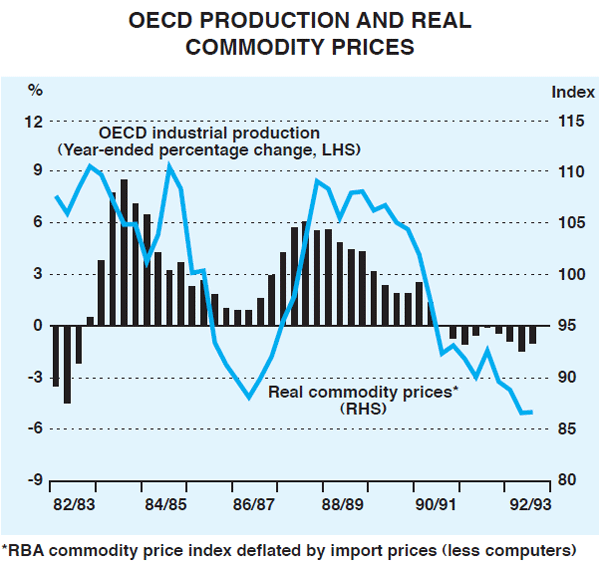
In the eleven months to May, the current account deficit was financed largely by official sector capital flows; State governments borrowed $8.7 billion abroad and the Reserve Bank reduced its Official Reserve Assets by $4.2 billion.
At the end of March 1993, total net liabilities owed abroad amounted to $208 billion (53 per cent of GDP). Net foreign debt was $161 billion (41 per cent of GDP), of which official sector debt was $31 billion.
Monetary and Credit Conditions
Credit conditions eased slightly during the June quarter, with the 0.5 per cent reduction in cash rates in late March flowing into similar cuts in intermediaries' deposit and loan rates between mid April and early May. Business indicator rates now range from 9.5 to 10 per cent. The predominant rate for owner-occupied housing loans is 9.5 per cent.
The full response of borrowing demands to these changes is yet to be seen but, on the evidence available, overall growth in credit remains very slow. Credit provided to the private sector by financial intermediaries increased by about 1 per cent in the three months to May (3.9 per cent at an annual rate), to be just over 2 per cent higher than a year earlier (Table 4). The increase was a result of strong demand for housing loans, the outstanding value of which has increased by more than 18 per cent over the year. This strength reflects the expansion in dwelling investment, and is underpinned by the attractive packages on offer to borrowers. In May and June the competition to lend for housing intensified with the announcement of ‘headline’ rates as low as 5 per cent for six months or 6.5 per cent for one year. While there are substantial short-run cash flow benefits to households from such special deals, the interest rate on these loans reverts to the standard variable rate after the initial period. The effective rate over the life of an average loan is around 9.2 per cent, only a little below the predominant standard rate.
| November 1992 | February 1993 | May 1993 | |
|---|---|---|---|
| Currency | 7.7 | 6.3 | 5.9 |
| M1 | 6.4 | 8.0 | 15.2 |
| M3 | 0.3 | 9.3 | 4.0 |
| Broad Money | −1.5 | 3.1 | 5.6 |
| Credit | 3.3 | 1.2 | 3.9 |
| Housing | 19.0 | 16.3 | 17.8 |
| Personal | 2.2 | 0.4 | −0.9 |
| Business | −3.1 | −3.4 | −2.8 |
| * adjusted for statistical reclassifications where appropriate | |||
Credit extended for other purposes remains flat. Other personal credit is largely unchanged from mid 1992, which is consistent with relatively low growth in purchases of household durables and motor vehicles. Demand for business credit is very weak, reflecting low investment and continuing balance sheet restructuring. Business credit outstanding fell in April and May, offsetting the rises in February and March. Adjusting for statistical re-classifications, this left business credit some 3 per cent lower than a year earlier. Equity raisings, which were very strong during 1992 and then weakened early in 1993, picked up a little in May.
Competition to attract small to medium-sized business borrowers has stepped up, with some banks offering further special deals. These include discounts of up to 2¼ per cent for variable rate loans or competitively-priced fixed rate loans for terms of up to seven years. Evidence from the ACCI/Westpac survey of manufacturers suggests that the combination of lower general interest rates and the various special offers have improved perceptions of the availability of finance, for both small and large firms (Graph 11).

Growth in the broader monetary aggregates, M3 and Broad Money, has been fairly slow, consistent with the moderate funding requirements of financial intermediaries. M1 growth remains volatile, affected by the introduction of new types of account which affect deposit classifications in the statistics. Currency growth is on a trend of around 5–6 per cent per annum, consistent with the moderate growth in nominal spending.
Financial Markets
The exchange rate was the major focus of attention in financial markets in the June quarter. The rate was under downward pressure for much of the quarter, and subject to more volatility than had been evident for some time. These developments also had a significant influence on the behaviour of domestic markets, in particular tempering the bullish tone that was tending to exert itself in those markets.
The weakness of the exchange rate reflected a number of factors. The most important was the downward revision to short-term growth prospects for the world economy, and the associated weakening in commodity prices. These effects re-emerged in April and continued through most of the quarter.
Another important influence was the run of poor current account data. The exchange rate weakened noticeably around the times these data were published, but particularly when the April figure was published at the end of May. Markets had been expecting a low deficit after the sharp increase the previous month, and were disappointed by another high figure. Over the space of a couple of days, the exchange rate fell by about US2 cents, to under US67 cents. This was around the lows reached last January. The exchange rate traded mainly between US66.5 cents and US67.5 cents over the rest of the quarter (Graph 12), before picking up a little, to over US68 cents, in early July on the back of a rise in some commodity prices, particularly gold prices.
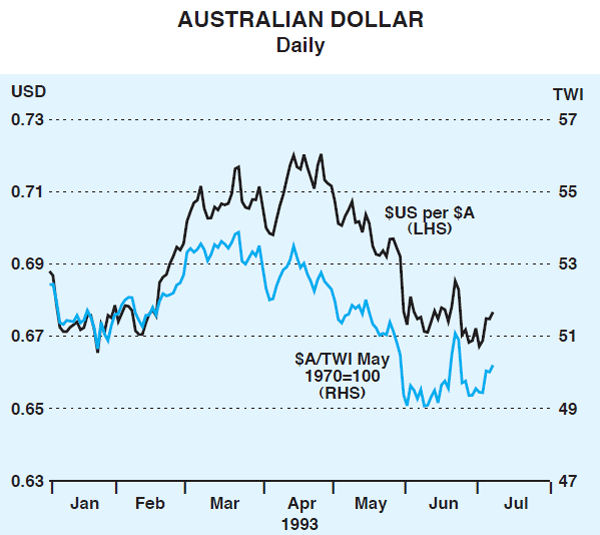
In trade-weighted terms, the exchange rate weakened more than it did against the US dollar. This reflected the fact that the yen continued to strengthen sharply against all currencies during the quarter. Against the US dollar, the yen was up by 7 per cent over the quarter; against the Deutschemark, it was up by more (11 per cent) as the Deutschemark itself tended to weaken over the quarter (Graph 2). Reflecting these influences, the trade-weighted index reached a new low of 49.1 in early June. It recovered a little to 49.5 at the end of the quarter, down 6 per cent during the quarter and 10 per cent over the year. This followed a fall of 8 per cent the previous year.
The Bank intervened in the market on several occasions to moderate the fall in the exchange rate. Over the quarter, the Bank made net purchases of Australian dollars amounting to $1,658 million, compared with $1,376 million in the previous quarter.
The effects of the softer exchange rate was evident at both the short and long ends of the yield curve. At the short end, rates were fairly steady during the quarter. Cash rates were maintained at 5.25 per cent, after the easing of 0.5 per cent in late March, and security yields by and large traded around a similar level (Graph 13). This steadiness, however, reflected tension between the effects of generally weak economic data released during the quarter, which tended to spur markets to push yields down in anticipation of a further policy easing, and the weakness in the exchange rate, which operated to dispel expectations of an easing and pull yields back to the prevailing cash rate. Yields on 90-day bank bills ended the quarter at 5.25 per cent.
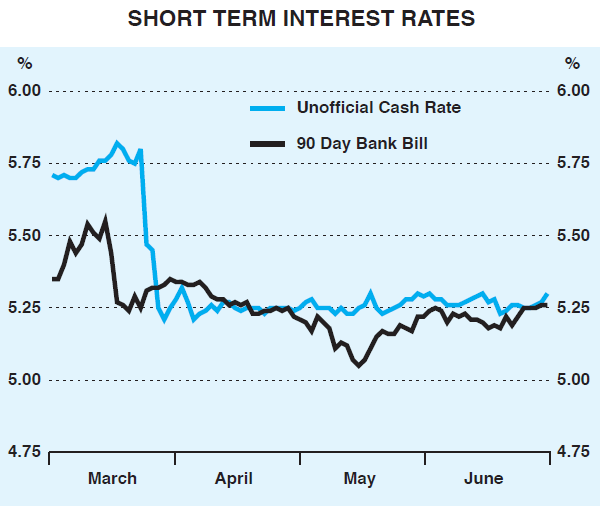
The steadiness in Australian short-term rates was against a backdrop of unchanged rates in the US and Japan, but falling rates in Europe (Graph 14). In the United States and Japan, short-term rates remained around 3 per cent. In Germany, as noted earlier, rates were reduced by about 0.6 per cent over the quarter, to 7.6 per cent (they have fallen by a further 0.3 per cent since). Other European countries also cut their rates during the quarter, in some cases by more than Germany.

In the bond market, yields fluctuated over the first half of the quarter in response to nervousness about the exchange rate. They reached their high point (7.8 per cent) in early June at the time of the sharp fall in the exchange rate. An additional factor during this period was the rise in bond yields overseas.
During April and May, for example, concerns that inflation in the US might be accelerating despite the weakness in the economy caused US bond yields to rise. Subsequently, these inflationary fears receded and yields fell back (Graph 15). This provided a better environment for Australian yields, which also fell noticeably over the second half of the quarter. Yields on 10-year bonds in Australia ended the quarter at 7.4 per cent, compared with 7.7 per cent at the end of March. They moved down a little further in early July.

Share prices rose by 4 per cent over the quarter, mainly on the back of reports of some healthy company profits and the jump in gold prices. The rise in Australian share prices was not as strong as in Japan, but exceeded the rise in the United States and contrasted with the generally flat prices in Europe.